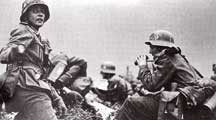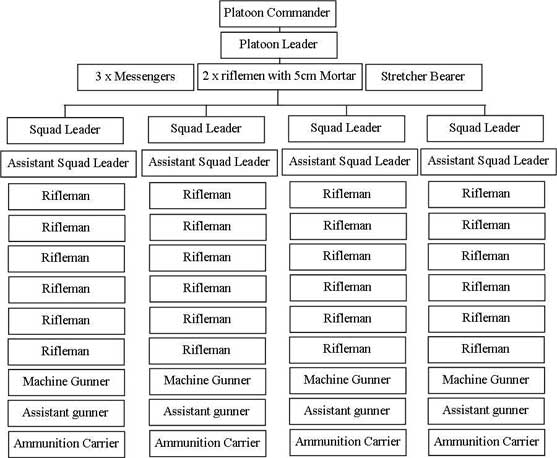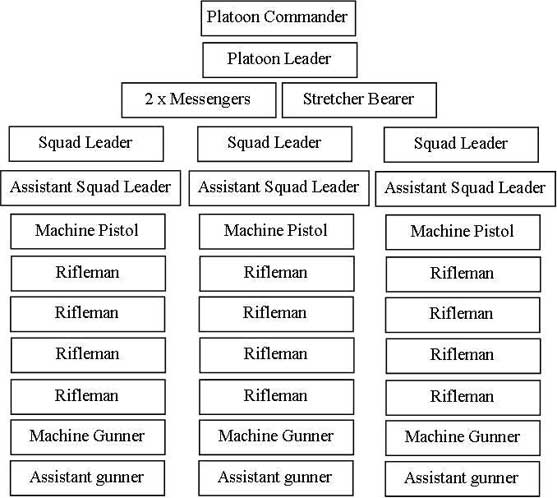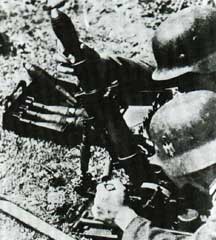The
Men Behind the Counters
The German Infantry
Platoon
By Dave Murray
January 2013
In the second of this series on the
men behind the counters I look at the
workhorse of the German army, the infantry
platoon.
 The
ubiquitous German infantry platoon was the
backbone of the German military machine. While
the Panzers and Luftwaffe get the glory, this
humble unit paved the way for Germany’s
initial successes and ultimate tenacity on
the defence. The
ubiquitous German infantry platoon was the
backbone of the German military machine. While
the Panzers and Luftwaffe get the glory, this
humble unit paved the way for Germany’s
initial successes and ultimate tenacity on
the defence.
The German standard infantry platoon is
at the heart of what made the German military
machine of the Second World War so formidable.
The infantry platoons of the German army had
far more freedom of action than that of other
nations. It was left to the men on the ground
to decide the most appropriate way of achieving
their objective, and junior officers were
encouraged to choose the most “aggressive”
choice if appropriate. These small units taking
quick, decisive action decided the outcome
of many battles.
German infantry training created a strong
“espirit de corps” among the men
of a platoon. Despite the heavy losses and
reduction in quality of some units as the
war dragged on, there was always a small core
of experienced men that led by example and
maintained a strong sense of purpose and discipline.
A typical German platoon in 1939 as they
advanced through Poland is represented by
a 5-3 INF counter. It would have consisted
of the following:
- 1 platoon commander armed with a pistol
- 1 platoon leader, a NCO armed with a
rifle (he would normally command the mortar
section)
- 3 messengers armed with rifles.
- 2 soldiers armed with rifles and equipped
with a 5 cm mortar.
The platoon would have 3 squads each with:
- 1 squad leader, a NCO armed with a rifle.
- 1 assistant leader, a NCO armed with
a rifle.
- 7 soldiers armed with rifles.
- 4 soldiers manning one MG34 with pistols
and one rifle.

The large squads of the infantry platoons
were found to be too cumbersome to use in
actual combat and after the fall of Poland
they were reorganised into smaller 10-man
squads. By the time of the invasion of Russia
the platoon had evolved into the following
(still represented by a 5-3 INF counter):
- 1 platoon commander armed with a submachine
gun and an automatic pistol.
- 1 platoon leader, a NCO armed with a
pistol.
- 3 messengers armed with rifles (one equipped
with telescopic sights.)
- 1 stretcher bearer armed with a rifle
(this soldier was actually part of the company
train but one was routinely attached to
each platoon).
- 2 soldiers armed with rifles and equipped
with a 5cm mortar. (The 5cm mortar was not
a popular weapon, being heavy and not very
effective, and on the Eastern Front was
routinely not deployed.)
The platoon would have four squads each
with:
- 1 squad leader, a NCO armed with a rifle
being replaced by the MP40 as stocks warranted.
- 1 assistant leader armed with a rifle.
- 6 soldiers armed with rifles.
- 1 machine gunner with an MG34 and pistol.
- 1 assistant gunner with a pistol.
- 1 MG ammunition carrier with a rifle.

That was the shape of the Wehrmacht as they
swept into Russian in 1941. But the swift
victories that previous campaigns had suggested
did not come, and by late 1942 to 1943 the
German army had to take stock of their losses
and were forced to change the structure of
the platoon. Manpower was decreased but compensated
by a firepower increase.
The game represents this by the late-war
6-3 GREN counter. This counter sees the firepower
of the platoon increase by 1, but the unit
is also now more brittle, having a reduced
strength of just 2-3 to reflect the lower
number of soldiers present. The revised platoon
structure also saw the renaming of the infantry
soldier into Grenadiers, hence the GREN on
the counter.
A typical late-war infantry platoon counter
would consist of the following:
- 1 platoon commander armed with an MP40
and a pistol.
- 2 messengers armed with rifles.
- 1 stretcher bearer, armed with a pistol.
The platoon would have three squads each
with:
- 1 squad leader, usually a NCO armed with
an MP40.
- 1 assistant leader armed with an MP40.
- 1 soldier armed with an MP40.
- 4 soldiers armed with rifles.
- 1 machine gunner with an MG42.
- 1 assistant gunner with a rifle.
The platoon also had two unallocated machine
guns although in reality there may have been
none available. Also each squad would have
been allocated probably two Gewehr 43 semi-automatic
rifles, which had a higher rate of fire than
the standard Gewehr 98 K bolt-action rifle.

As the war continued into late 1944 and
1945 these structures were often severely
depleted, and only offer guidelines as to
what a formation on the ground would actually
look like.
In the previous article on Panzer Grenadiers
we looked at the guns of the Wehrmacht forces.
In this instalment I look at the other equipment
available to the German infantryman as the
war progressed.
The Soviets T34s were a revelation to the
German military when the anti-tank guns supplied
to the infantry were unable to penetrate the
front of these tanks. For the first couple
of years of the war on the Eastern Front the
only way the infantry could deal with these
tanks was close assault using a Teller mine
or a bundle of stick grenades.
 The
Teller Mine The
Teller Mine
The Teller mine was the standard German
anti-tank mine used throughout the war. It
had a carrying handle and magnetic underside
to enable it to adhere to enemy vehicles;
when employed thus it also has a timer mechanism
to enable the soldier to get clear before
it exploded.
Stick Grenades
The Stielhandgranate was the standard German
grenade of the war and an improved version
of the grenade used in the First World War.
This versatile weapon allowed up to six grenades
to be strapped together to form an improvised
anti-tank weapon.


Anti-Tank Grenades
At the outbreak of war the German infantry
had as their main anti-tank weapon rifle grenades
that could be fired from a standard Gewehr
98K rifle by use of a Schiessbecker device.
These were relatively ineffective even at
the start of the war, but remained in service
as there was no alternative available.
One of the strangest anti-tank grenade devices
was the Kampfpistole, a modified standard
signal pistol that could fire a tiny anti-tank
grenade. Needless to say this weapon proved
almost entirely useless.
 5
cm Granatwerfer 36 (Mortar) 5
cm Granatwerfer 36 (Mortar)
This over-complex and heavy small mortar
was not popular with the infantry; its range
was too short and effect blast radius small.
By 1941 this weapon was out of production.
On the eastern front the German infantry made
far more use of captured Soviet 5 cm mortars
which were lighter and had greater range.
Panzershrek 8.8cm
The capture of American Bazookas in Tunisia
in 1943 inspired the Germans to copy its design
and produce their own version, officially
called the Raketenpanzerbüchse but more
commonly known as the Panzershrek. The original
design required the user to wear special clothing
to protect the user from the rockets exhaust
gases, but the later addition of a face shied
deemed this unnecessary. A very effective
weapon, it relied on the nerve of the infantry
man to get close enough for a hit, although
a hit usually meant a dead tank!

Panzerfaust
Another remarkable weapon produced in Germany.
It projected a hollow-charge grenade that
could penetrate up to 200 mm of armour at
a 30-degree angle. Initially introduced in
1943 with a range of just 30 meters, it took
a lot of nerve to get in range, but a hit
meant a dead tank. The range was eventually
increased to 60 meters. Cheap and quick to
produce, and requiring a minimal amount of
training, this deadly weapon was produced
in vast quantities. It was a very effective
weapon as the German army moved on to the
defensive.

Next up: The Soviet infantry platoon
counter from Eastern Front Deluxe and
Road to Berlin.
Put these troops into action. Order Kursk: South Flank right here. |


